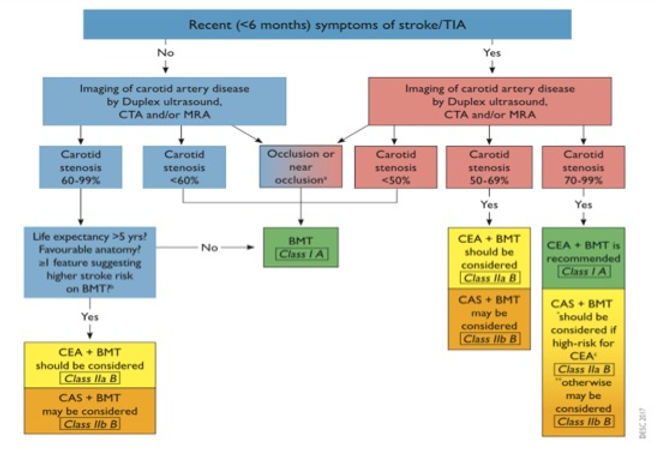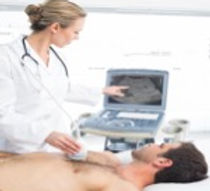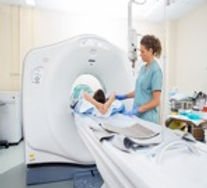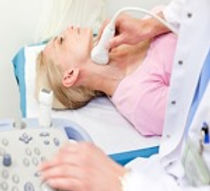
WHY OCTOGONE MEDICAL?
Cerebrovascular Accident (CVA) is a worldwide disease in progression, source of mortality and major disability.
CVA is a sudden loss of brain function due to an ischemic stroke or hemorrhage
Ischemic stroke (85% of strokes) results from the occlusion of a cerebral artery that prevents the brain from being supplied with oxygen by normal blood flow
This may be due to :
Atheroma (30%): An atheroma is a fatty deposit located on part of the inner wall of an artery that impedes blood flow
Embolism (20%): A blood clot that blocks an artery and interrupts blood flow to the brain.
Other (30%)
Among these causes, carotid plaque is responsible in 15% of the ischemic CVA and could be involved in the mechanisms of more than 70% of ischemic strokes
Carotid plaque, mainly from atherosclerotic origin (Figure 1), is encountered frequently : an estimated prevalence of 5 to 10% of people over 65 years old with stenosis > 50%
It is favored by cardiovascular risk factors: tobacco, hypertension, diabetes, sedentary lifestyle, etc...
According to the Stroke Action Plan for Europe, the total number of strokes in the EU is expected to increase from c.610 000 in 2015 to c.820 000 in 2035, an increase of c.35%, due to an aging population*
The WHO qualifies this 21st century disease as a "pandemic”
CVA can lead to death or permanent disability – can have health, social and financial consequences and can be life-altering for stroke victims and their loved ones
Stroke victims’ life depends on the speed and accuracy of the diagnosis and the effectiveness of treatment
Stroke is a major public health problem and will continue to be for years to come
Stroke has a significant economic cost for our societies. Total expenditure caused by strokes was estimated at c.€45bn in 2015 and is expected to increase
A huge economic stake for States whose public accounts have deteriorated sharply in recent years, particularly following the Covid-19 crisis
It’s therefore crucial to predict stroke more accurately and effectively



Clinical Examination
Patient interview and clinical examination
Nature and severity of the symptoms
Patient's history, risk factors and age
Detection of transient ischaemic attack or stroke
Cost: 200 € per consultation and patient

Cardiac Exploration
ECG monitoring by a Holter
Installation of a long-term subcutaneous recorder (Reveal)
Hypertension, Atrial fibrillation (AF)
Cost: 1500 € per patient

CT Scanner
Medical imaging device through x-rays allowing 2D/3D visualizing of blood vessels
Ipsilateral silent infarction
Carotid plaque characteristics
Cost: 1 million € per machine

Echo-Doppler / IRM
Imaging exam of the vascularization of supra-aortic trunks, including visualization of the aortic arch, carotid bifurcations and intracerebral arteries
Plaque evaluation (volume of plaque, volume of necrotic nucleus)
HITS 30 000 €
MRI : 1.5 million €

WHY OCTOGONE MEDICAL?
Trials validating that the current diagnosis management is out-dated since it does not take into account other considerations
No imaging modality (MRI, CT Scanner, Doppler) is capable of accurately and individually predicting when the carotid plaque could rupture à No customization of the diagnosis
All current modalities only analyze the plaque at a given time, often one time late
Diagnostic techniques rely mainly (or only) on the degree of the stenosis while:
For significant stenosis (>50%): Decreased benefit of surgery due to the progression of optimal medical treatment (use of statins and anti-thrombotic therapy)
For small stenosis (<50%): Usually untreated but can also cause a stroke
No current modalities focus on the interaction of plaque and arterial wall stiffness or shear wave loading ( i.e., a seismic wave equivalent that passes through the arterial wall and plaque over time) while hypertension, the major risk factor for stroke, increases the strength of the shear wave
No analyzable databases to assess the risk of plaque rupture and detachment
Paradox: even though we know the risk factors responsible for 90% of strokes, It remains difficult to reduce the terrifying number of new strokes each year All projections show that if the current approach is maintained, the burden of stroke will not decrease over the next decade
We need a more effective and relevant diagnostic system

WHAT WE PROPOSE

